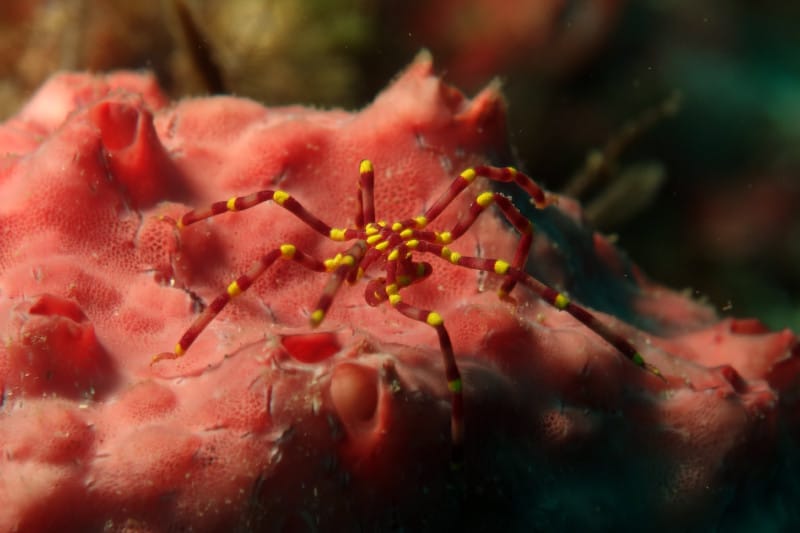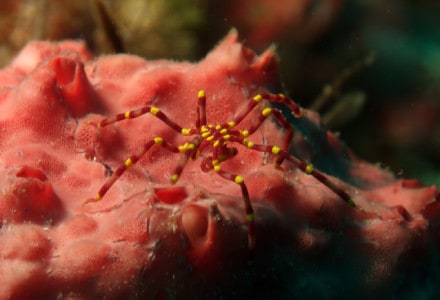
Photographer: Sylke Rohrlach
CC License: http://bit.ly/2RcCTlc
Sea Spider Facts
- Perhaps most notably, the term Sea Spider serves as the collective common name of a rather enormous order of marine arthropods. In point of fact, this incredible order includes more than 1,300 recognized species. Also, other species remain under consideration for entry into this order, as well.
- Furthermore, these amazing creatures appear to be extremely widespread. In fact, together, the various members of this order occur in virtually every ocean and sea around the world. This habitat range even includes many areas that most people consider inhospitable.
- However, despite the common name, these obviously do not represent true spiders, or even arachnids. But nevertheless, these remarkable arthropods actually do have more in common with true spiders than other arthropods. That fact alone makes them a remarkable type of creature.
- Furthermore, one particular variety of Sea Spider represents an especially unique case. This holds true even when considered alongside its fellow members of the order. That’s because this rather startling variety actually evolved over the ages into a fully hermaphroditic species.
Related Articles
Tailless Whip Scorpion Deer Tick Yosemite Cave Pseudoscorpion
Photo Credit: NOAA
CC License: https://bit.ly/3lOx4N4
Sea Spider Physical Description
Given the vast number of types of Sea Spider, physical characteristics quite naturally vary widely among the numerous different species. However, no noticeable degree of sexual dimorphism presents itself among any of the known varieties.
For example, leg spans range from a minuscule 0.04 in (1 mm) to as much as 2.3 ft (70 cm). Most varieties possess eight legs, but a few species develop 10 or even 12 appendages. Yet in all known forms, the legs grow extremely long and thin in relation to the body.
One rather interesting fact stands out, however. That’s because, due to the extremely small size of the body, these remarkable arthropods possess no respiratory system. Instead, the creatures acquire oxygen through the process of diffusion.
Furthermore, base colors vary quite significantly between the various types. Not only that, but sheer physical appearance also differs widely between species. But, the characteristic trait of having a tiny body and comparatively long, thin legs remains a constant.
- Kingdom: Animalia
- Phylum: Arthropoda
- Class: Pycnogonida
- Order: Pantopoda
Photo Credit: NOAA
CC License: https://bit.ly/3CGTc1J
Sea Spider Distribution, Habitat, and Ecology
First of all, the truly fascinating members of the order collectively known as the Sea Spider possess a completely cosmopolitan distribution. In point of fact, the various species appear to exist in all oceans and seas throughout the world.
However, the majority of the various species do appear to live in several large concentrations, in specific regions. These population groupings occur relatively near the coasts of Australia, New Zealand, and the United States, in North America.
Additionally, a great majority of species, and indeed individuals, prefer to inhabit relatively shallow regions. However, some species and individuals separate themselves from that pattern. These exceptions sometimes live as deep as 23,000 ft (7,000 m).
Furthermore, most species feed primarily as either active predators or passive scavengers. Also, the typical prey for most varieties varies, but consists mainly of sponges, cnidarians, polychaetes, and bryozoans, depending on location.
Finally, except for the one hermaphroditic species, reproduction involves external fertilization of eggs. Interestingly, after these have been laid, only the male cares for the eggs and young. This represents yet another way in which the Sea Spider remains a fascinating form of life.
Species Sharing Its Range
Blanket Octopus Blue Shark Bobbit Worm
Check out our other articles on 10 Dazzling Denizens of the Deep, Geoffroy’s Cat, Gocta Cataracts, Gympie-Gympie, Leatherback Sea Turtle, Giant Mesquite Bug, Little Penguin

